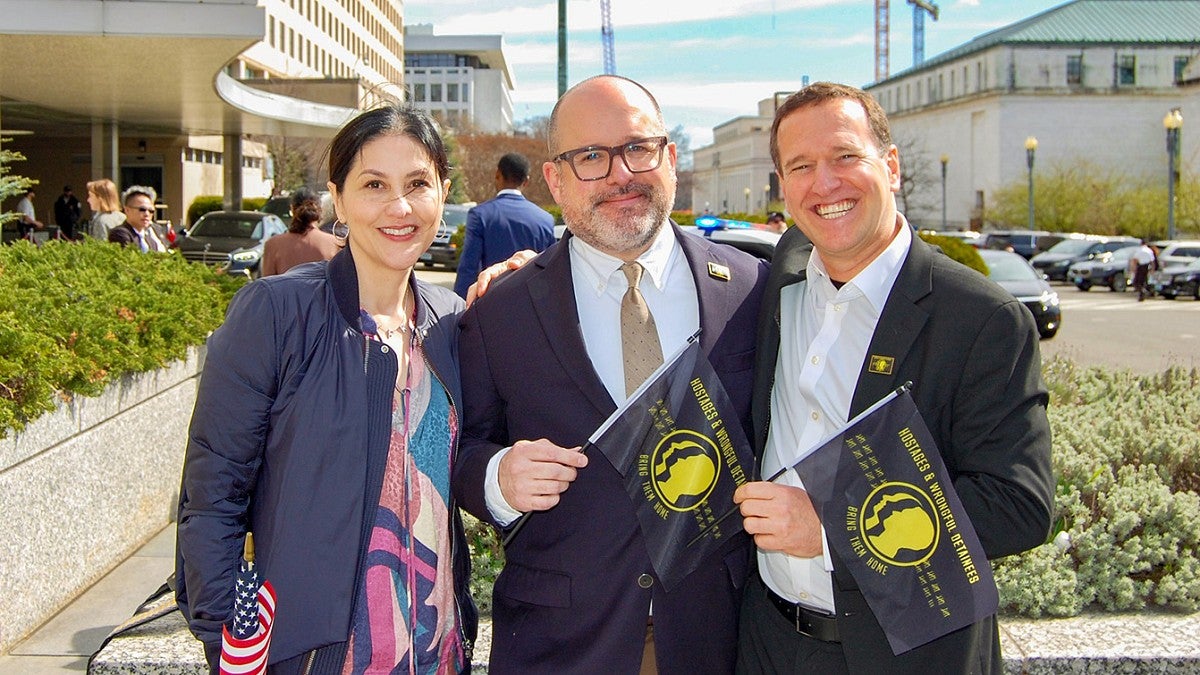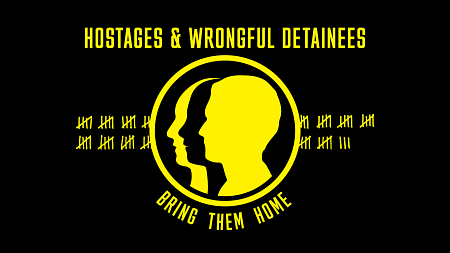
On March 9, when the Hostage and Wrongful Detainee flag fluttered over the U.S. Capitol for the first time ever, UO Professor of Practice David Ewald took pride knowing that he — and his advertising students at the UO School of Journalism and Communication (SOJC) — played a significant role, not only in creating the flag, but in shedding light on the plight of families with loved ones held overseas.
For the past two years, Ewald has volunteered on behalf of Bring Our Families Home, a campaign organized by families of Americans held hostage or wrongly detained, to urge the Biden administration to do everything in its power to secure the release of the detainees.
Ewald became involved in the campaign two years ago when a friend asked for his opinion on the design of a flag for the group. He was intrigued.
As he learned more about the families’ predicament, his role became more than a favor to a friend; he was moved to do more.
Students get a glimpse of ‘advocacy advertising’
Ewald soon realized the families’ cause offered an opportunity to teach his advertising students about advocacy advertising — how to use design and persuasion skills to promote something greater than themselves.
Ainsley McRae, a student who watched the evolution of the flag design, said the experience “completely changed the way I think about my practice.”
“Seeing this flag from a projector screen in Allen Hall to flying around the country has revolutionized my perception of the impact that design can have,” McRae said.
To create a design for the flag, Ewald met with 50 families, and over the course of his work, he developed hundreds of versions. Students from his undergraduate advertising courses as well as his Advertising and Brand Responsibility Master’s classes offered critiques and feedback on the flag iterations.
The project was, in some ways, similar to creating branding for a product or company.
“The families needed some form of collective representation and visualization,” he explained. “So the form of the flag preempted the idea of a brand.”
The flag was created as a unifying symbol. “Everybody’s from different walks of life,” he said. “But we use that form of a flag as the medium to explore what the brand could be.”
For Neda Sharghi, sister of Emad Shargi, an Iranian American businessman who was released in December after being wrongfully detained in Iran since 2018, the flag means more than words.
“This flag gives legitimacy to our experiences, makes us feel seen and heard and brings the issues of hostage diplomacy out of the shadows,” she said. “Even more, it makes us feel even more connected to the principles and values of our nation — freedom, community and looking out for one another. It reaffirms that America doesn’t leave its own behind, that we fight for another, that we have each other’s back.”
To supplement the flag discussion, Ewald also invited classroom speakers from the hostage advocacy movement, including The Washington Post journalist Jason Rezaian, the SOJC’s 2024 Ruhl lecturer whose release from an Iranian prison was supported by the BOFH campaign.
He also brought in Mickey Bergman, who has worked with more than 150 families, and Vince Kozar, president of the Phoenix Mercury Basketball team, which advocated for the release of WNBA player Brittney Griner from detainment in Russia.

Flag represents voices of detainees and families
The final version of the flag depicts the work from Ewald and the 50 families who offered feedback. The black flag with bright yellow lettering reads, “HOSTAGES AND WRONGFUL DETAINEES” atop an image of three silhouettes of people in profile. Under the image, a message reads, “BRING THEM HOME.” The design includes 93 slashes representing endless days in confinement.
“The tally marks symbolize the days, weeks, months, years, and even decades that our loved ones have unjustly suffered in the hands of foreign countries or groups, reminding the government and the public of the need to #BringThemHome before it’s too late,” reads a description on the Bring Them Home website.
Second flag in U.S. history to symbolize a national cause
The creation of the flag was part of a bigger effort by the families to get Congress to officially designate a day to honor the hostages and wrongful detainees. In January, President Biden signed into law the Robert Levinson Hostage Recovery and Hostage-Taking Accountability Act, which designates March 9 as U.S. Hostage and Wrongful Detainee Day and designates the Hostage and Wrongful Detainee Flag to recognize and prioritize the freedom of citizens and lawful permanent residents held as hostages or wrongfully detained abroad.
The flag was only the second in U.S. history — the first was the POW flag — codified as a symbol for a national cause. It will be flown on federal buildings every March 9.
“I see it as a tangible example of what is possible with grassroots action and partnership. The flag itself moved from an idea, to distinct concepts, to a symbol, to a law over the course of two years,” Ewald said. “That never would have happened were it not for shared action by the families, members of Congress, countless people behind the scenes and others. Action takes time for hostages and their families. The resilience and drive that these families have shown is equally inspiring and heartbreaking.”
Advertising as a vehicle for social change
Ewald’s work has also sparked interest for advertising students who want to take on social justice and action roles.
“Everybody wants to do good things with their work,” Ewald said. “And it is a balance all the time to figure out how you can leverage the talent and the platform that you have at a business to enact some sort of social change.”
The best advice Ewald has for students interested in these roles is to surround yourself with people who are involved in the cause you are interested in. It’s also important to consider the potential impact of your work.
“There are so many different things that are possible,” Ewald said. “And if you intentionally step outside of that present path, there’s a lot of opportunity. But I think it takes intention to recognize that and even to consider doing it.”
—By Sophie Fowler, class of ’26
Sophie Fowler, class of ’26, is an advertising major with a minor in multimedia. You can connect with her on LinkedIn.
